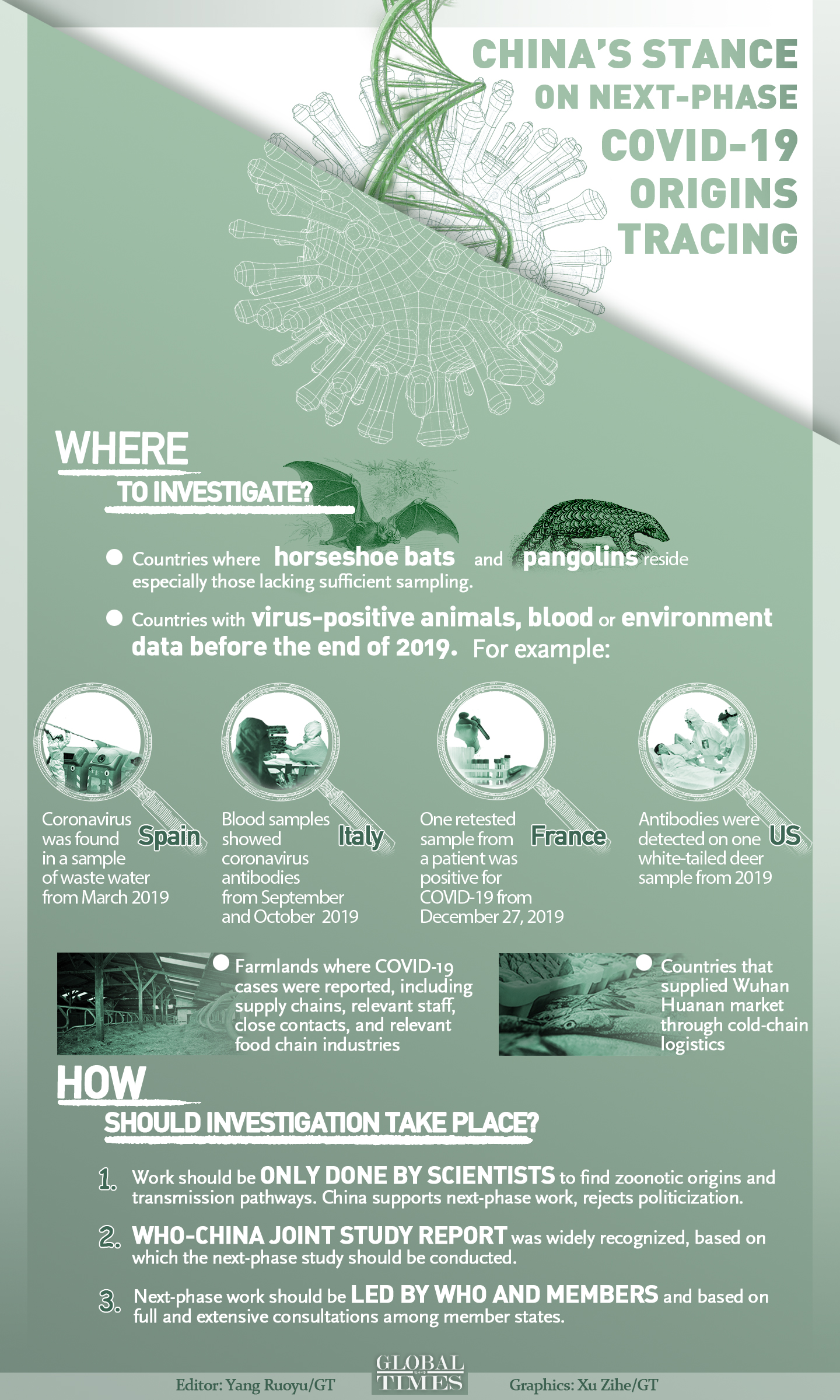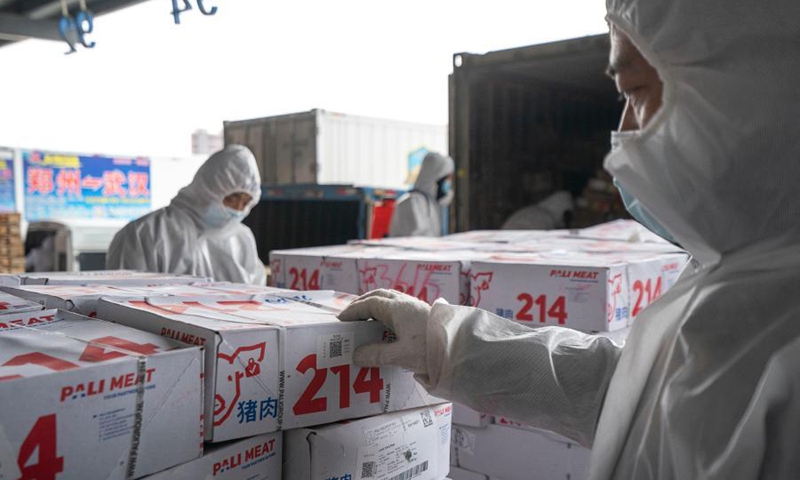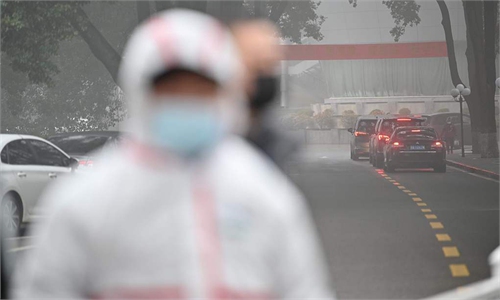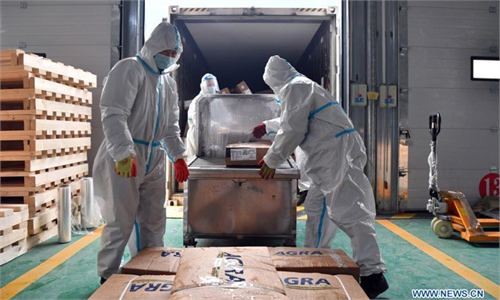Exclusive: China CDC experts suggest survey on cold-chain suppliers to Wuhan in WHO’s 2nd-phase probe on virus origins

China's stance on next-phase virus origins tracing: Investigations should be carried out in countries such as where horseshoe bats & pangolins reside, those with virus-positive animal data and who supplied Wuhan Huanan market through cold-chain logistics. Editor: Yang Ruoyu/GT Graphic: Xu Zihe/GT
Amid the consensus among worldwide scientists that the second phase of the study on coronavirus origins should be carried out in multiple places, officials and experts from the Chinese Center for Disease Control and Prevention (China CDC) suggested that the WHO should take cold chain as a key clue and directly probe the countries where the virus had been found on samples of their cold-chain products and conduct epidemiological survey on cold-chain workers from countries that shipped products to Wuhan in 2019.
With more evidence emerging based on epidemiologist investigations, tests and viral molecules research that suggests it is possible that the early outbreak in Wuhan's Huanan seafood market at the end of 2019 may have been sparked by cold-chain imports, they called on the WHO to set up a global cold-chain tracking cooperation mechanism to monitor coronavirus transmissions through cold-chain products and to conduct an epidemiological survey or serum samples detections on cold-chain workers from countries that shipped products to Wuhan between September and December in 2019.

Staff members paste QR codes on imported cold-chain food for traceable management at a regional cold chain center in Wuhan, capital of central China's Hubei Province, Jan. 7, 2021. Photo: Xinhua
Vigorous evidence in cold-chain
Several sporadic outbreaks in China last year were found to be related to imported cold-chain products from other parts of the world, including Europe and the American continent. In many of these places, signs of the coronavirus were discovered earlier than in Wuhan. Global Times reporters had visited Wuhan several times and talked with merchants from the Huanan Seafood Wholesale Market, where the earliest cluster infections in the country were reported. Through field investigations and interviews with prominent virologists and epidemiologists, the Global Times had brought about a hypothesis: did the early outbreak in Wuhan originate from imported frozen food?
The hypothesis quickly attracted wide attention at home and abroad, prompting many scientists to consider the hypothesis in order to pinpoint the origins of the virus.
In March, the WHO-China joint report on COVID-19 origins was released. The report concluded that introduction of the novel coronavirus through cold/food chain products is listed as a "possible" transmission pathway. This reignited discussions on the cold chain hypothesis.
"After China contained the early outbreak in April 2020, sporadic outbreaks occurred in Beijing and Dalian [in Northeast China's Liaoning Province] in that summer. We conducted epidemiological investigations, nucleic acid testing, antibody detections, cold-chain food retrospection and comparative analysis of viral gene sequencing of COVID-19 patients and food packages and confirmed that the virus was imported from other countries or regions through the cold-chain transportation," Ma Huilai, an official from the China CDC, told the Global Times.
The outbreak in Qingdao, East China's Shandong Province, in October further proved the hypothesis as it was the first time that living novel coronavirus has been isolated from the outer packaging of cold-chain food. "We began to know once the virus enters in some places, such as seafood markets or aquatic products factories, it could trigger a new round of COVID-19 spike," Ma said.
Afterwards, cities across China also experienced coronavirus transmission which was traced back to imported cold-chain food. Wuhan was one of these cities where a batch of frozen pork imported from Brazil and frozen beef from Uruguay tested positive for coronavirus in December 2020.
"Given the points above, the chain of evidence for the cold-chain transmission has become relatively complete," said Ma. "It proves that coronavirus can be carried long distances on cold-chain products and it is highly indicative of the possibility that the outbreak in Wuhan's Huanan seafood market in December 2019 might have been sparked by cold-chain imports."
Liu Jun, a researcher from the China CDC who is also a member of the WHO-China joint expert team, told the Global Times that 390 of 678 stores in the Huanan seafood market had sold 29 types of cold-chain products from 20 countries and regions. They also found that the imported products sold during September to December 2019 in Wuhan came from 37 countries and regions, covering 440 types of cold-chain food.
"The number of confirmed cases in cold-chain products stores in the Huanan seafood market was significantly higher than other stores and the risks of infections for people working in cold-chain food stores were also over 3 times higher than other workers," Liu said.
Liu pointed out that among these countries, some reported positive cases or tested the virus in their environment or on samples in 2019 while some were residences to Rhinolophus and pangolins. The WHO should conduct serum samples and epidemiological survey for cold-chain workers in these countries for further study.
On July 30, Liu, together with another eight scientists, published an article on ChinaXiv, a Chinese open repository for scientific research, saying that there are multiple potential locations of the natural reservoir of the coronavirus, and Wuhan might be far from the place of origins.
As a hub of international communication in Central China, Wuhan received extensive international flights from cities around the world before the SARS-CoV-2 pandemic. Notably, many of these flights to Wuhan departed from Southeast Asian countries that overlap with the Rhinolophus and pangolin distributions, as well as multiple known sarbecoviruses. Before the pandemic, Wuhan was already at high risk of importing SARS-CoV-2 through cold-chain cargo arrivals from other parts of the world, the paper shows.
"It is necessary to establish a global monitoring system for coronavirus transmission via cold chain. If a country finds a positive sample related to the cold-chain import, the WHO can conduct a retrospective study on the export country, such as on whether contamination has occurred in the source country or whether the products are contaminated in the shipping process," Liu said.
In an exclusive interview published on Monday, Liang Wannian, team leader of the Chinese side of the WHO-China joint expert team, also told the Global Times that the study on cold-chain transmission should be carried out globally in the next step.
"A retrospective study should be conducted on international logistic companies and frozen food suppliers for Huanan seafood market in 2019, including nucleic acid testing of stock samples and serum testing of workers involved. The next-step study should also further complete the evidence chains to demonstrate the role of the cold chain in the introduction and spread of viruses and analyze the persistent viability and infectious activity of the virus under logistics conditions," Liang said.
Improved traceability management
Responding to some Western media reports which accused China of diverting the attention to the cold chain pathway on purpose, Ma noted that although China is the first country that discovered the clue of cold-chain transmission, internationally, COVID-19 outbreaks were also found in many companies related to the cold-chain food industry. For example, in the first half of 2020, at least 30 large meatpacking plants, slaughterhouses, and seafood processing plants in many countries experienced COVID-19 outbreaks.
According to Ma, China has formulated specific measures targeting the cold-chain industry, including regular nucleic acid testing of cold-chain workers, tightening sampling detection on cold-chain products from high-risk countries and areas and implementing informationalized traceability management system covering processing, transportation, storage and sales.

Infographic: GT



